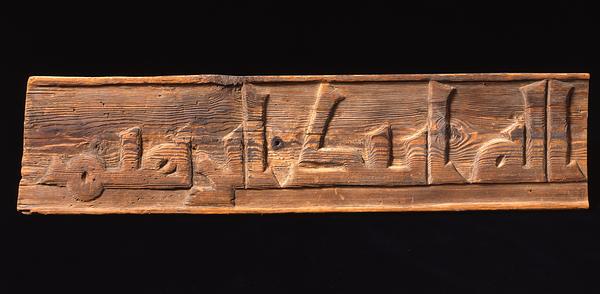Wooden panel, carved with a Kufi inscription, from the Ibn Tulun Mosque
Egypt, Cairo; c. 879
H: 29.5; L: 121 cm
The wooden panel comes from the Ibn Tulun Mosque, which was completed in 879 in Fustat, the forerunner of Cairo. The panel was originally part of an extant inscription frieze with passages from the Koran that is some two kilometers long.
This fragment has three words from sura 2, verse 133, in which Jacob’s sons promise their dying father, “We shall worship thy God and the God of thy fathers, of Abraham, Isma’il and Isaac, the one God: To Him we bow.”
The inscription is in a simple and robust Kufi script whose only decorative element is a little increase in width at the end of the letters. Each individual letter has emphatic weight, and the monumentality of the script was reinforced by giving nearly all the letters precisely the same lower edge.
The panel was purchased in Cairo in 1848 by the French consul, Delaporte, after restoration work on the Ibn Tulun Mosque.
Inv. no. 1/2002
Published in:
Tajan, Paris, 29/10-1985, lot 158;
David James [et al.]: Islamic calligraphy / Calligraphie islamique, Musée d'art et d'histoire, Geneve, Geneve 1988, cat.no. 1, pp. 52-53;
Sophie Makariou [et al.]: Memorias do Imperio Árabedo 13 de xullo ó 27 de setembro de 2000, Auditorio de Galicia, Santiago de Compostela 2000, cat.no. 44, p. 97;
Sheila S. Blair and Jonathan M. Bloom (eds.): Cosmophilia. Islamic Art from the David Collection, Copenhagen, McMullen Museum of Art, Boston College, Boston 2006, cat.no. 34;
Jennifer A. Pruitt: Building the Caliphate: construction, destruction, and sectarian identity in Fatimid architecture, New Haven 2020, fig. 1.24, p. 35;
Joachim Meyer, Rasmus Bech Olsen and Peter Wandel: Beyond words: calligraphy from the World of Islam, The David Collection, Copenhagen 2024, cat. 5, p. 121;

